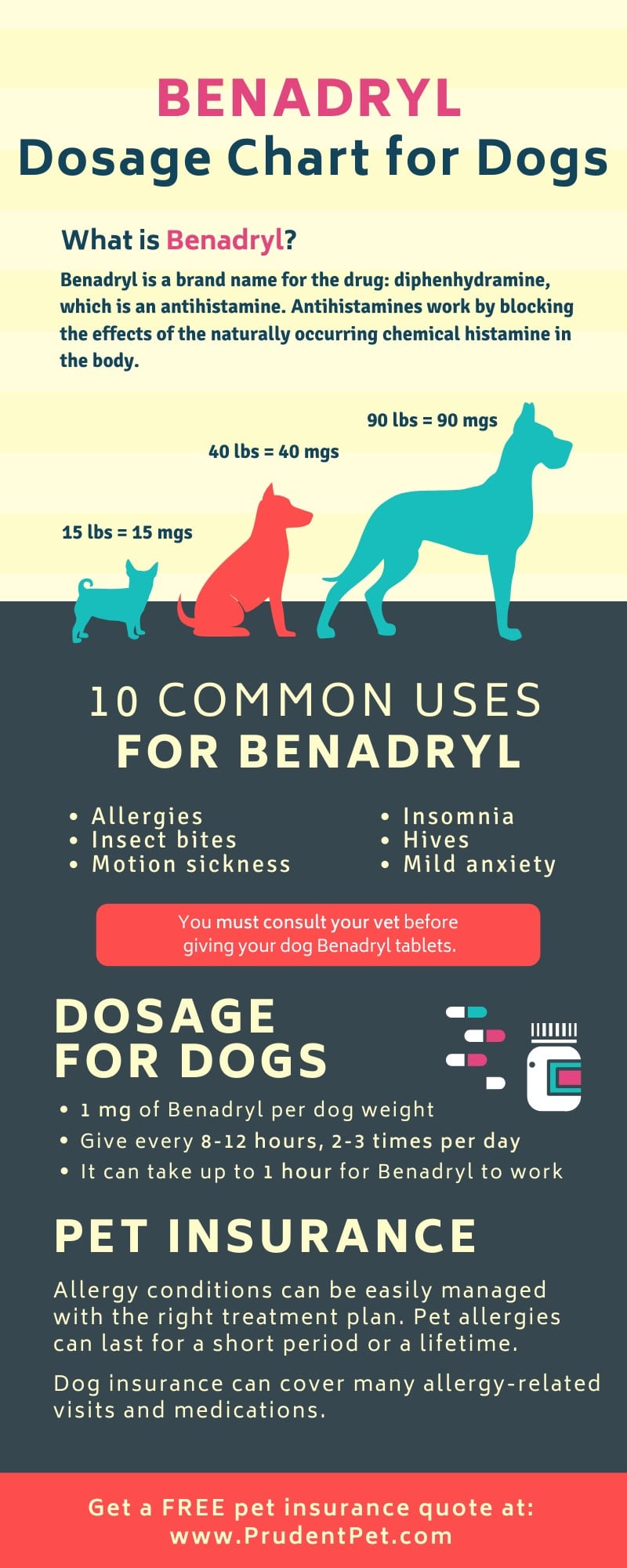Benadryl is a brand name for the drug: diphenhydramine, which is an antihistamine. Antihistamines work by blocking the effects of the naturally occurring chemical histamine in the body. Histamine is often produced during an allergic reaction. Benadryl is used for many different reasons:
- Decreases cold-like symptoms: sneezing, runny nose, watery eyes, or itching
- Reduces hives and skin rashes
- Prevents or treats allergic reactions and symptoms
- Treats motion sickness or to induce sleep
- Occasionally used for symptoms of Parkinson’s disease.
What Can Benadryl Be Used to Treat in Dogs?
Just like humans, antihistamines can be used to treat similar allergic reactions in dogs. The important aspect is to know whether your dog is having an allergic reaction or has chronic seasonal allergies. In addition, dogs may exhibit different symptoms that may not mimic those of humans, so it’s vital to know what to look for. In most cases, dogs who are having an allergic reaction may exhibit symptoms on the skin’s surface or have difficulty breathing.
Although your furry friend can show signs of allergies that are similar to those of humans, you’ll want to make sure that your pup doesn’t have a more serious condition at hand.
If you notice nasal discharge, coughing, or inflamed, reddened eyes, these can all be signs of a respiratory infection. Therefore, remember not to assume your pet’s allergies are causing these symptoms.
You may be thinking, “what is Benadryl for dogs?” and is it safe for you to give Benadryl to your pet? It all comes down to getting a comprehensive evaluation from your vet. If your fur baby is indeed suffering from an allergic reaction, your vet may recommend daily doses of Benadryl for dogs.
Signs and Symptoms of Allergies in Dogs
As we mentioned, the below signs and symptoms of allergies in dogs can also be indications of more serious illnesses. Don’t automatically assume any of these are just signs of allergies. However, if your vet notices these common symptoms, they may recommend treating them with an antihistamine like Benadryl. Some of the signs and symptoms of allergic reactions in dogs include:
- Sneezing
- Red or watery eyes
- Nasal congestion or drip
- Coughing or hacking
- Frequent awakening
- Difficulty breathing
- An audible whistling or wheezing sound when exhaling
- Raised, red patches of skin known as hives
- Eczema or itchy skin
Seasonal Allergies vs. Food Allergies in Dogs
There are many things in your home that may trigger an allergic reaction in your dog. Some of these may include:
- Dog bed stuffing or other fabrics
- Food allergies to treats, bones, or toys
- Other pets in the household
- Mold or dust mites
- Doggy shampoo or conditioner
- Indoor plants
- Essential oil diffusers or fragrances in the air
- Smoke from candles or cigarettes
It’s recommended to do a “trial and error” of what could be triggering your pet’s allergies. In addition to removing items from your house that might be causing allergies, the best advice is to clean thoroughly, wash the bedding often, and clean with all-natural products with no chemicals. Your vet may recommend Benadryl for dogs who have chronic allergic reactions to their environment.
On the other hand, food allergies will be dealt with by changing food brands or styles, not with Benadryl. This may include eliminating or adding grains, switching from different meats, or investigating other additives that could be in your pet’s regular food.
How Much Benadryl Should You Give Your Dog
The standard dosage for oral Benadryl for dogs is 1 mg per pound of body weight, given two to three times a day, or as needed. Most average diphenhydramine tablets found at the drugstore are 25 mg, which is the size used for a 25-pound dog. If you’re not sure how much Benadryl to give your dog or what kind of Benadryl is safe for dogs, make sure to contact your veterinarian. Below, we have included an easy to read, Benadryl for dogs dosage chart which can help you determine how much Benadryl to give your furry friend.
*Click to view the full image
Benadryl Side Effects In Dogs
Although Benadryl for dogs can be an excellent tool to help treat seasonal allergies and anxiety, every medication tends to have a few side effects. Just like for humans, it’s important to be aware of potential side effects associated with Benadryl for dogs. Benadryl side effects in dogs can range from extremely mild to more serious; therefore, it’s important to consult your vet as early as possible if you’re noticing any abnormalities.
Here is a complete list of potential Benadryl side effects in dogs:
- Drowsiness
- Dry tongue or mouth
- Increased heart rate
- Rapid breathing
- Increased urinary abnormalities
- Diarrhea
- Change in appetite or thirst
- Vomiting
Most Benadryl side effects in dogs occur within the first few hours, so always carefully monitor your furry friend after giving them this medication. Beforehand, make sure to discuss with your vet on what to do if your dog experiences any of the above Benadryl side effects.
Can Benadryl side effects in dogs be used for good?
Yes. In fact, some Benadryl side effects in dogs can be used to treat various health issues your furry pal may be experiencing. Your veterinarian may use Benadryl side effects in dogs, such as anti-anxiety and drowsiness, to help control behavior conditions or inflammation.
For example, with your dog’s seasonal allergies, Benadryl can be used to help decrease skin and throat inflammation. Also, vets may prescribe Benadryl for dogs if they are having difficulty sleeping due to chronic or seasonal allergies, which can help them get the necessary sleep they need to stay healthy.
Can Benadryl Be Used as a Dog Anxiety Medication?
Yes, vets may prescribe Benadryl for dogs if they experience symptoms of anxiety. Certain types of events can trigger pet anxiety, such as fireworks, travel, storms, etc. If your furry friend needs dog anxiety medication, talk to your vet to see if Benadryl could help.
Some common signs of anxiety in dogs are:
- Barking or howling excessively after you leave
- Panting more than usual
- Pacing back and forth nervously
- Shivering or shaking (when it’s not cold)
- Cowering in a corner of the house
- Digging inside or outside
- Escaping the yard frequently
- Destroying furniture or other items
- Excessive licking or chewing on their paws/fur
Before an event such as a holiday or festival, when fireworks may be released, your vet may instruct you to give your pal dog anxiety medication such as Benadryl to calm their nerves. Likewise, if your dog gets nervous on car rides, your vet may suggest you give them Benadryl before your trip. Always make sure to follow your vet’s instructions and never self-prescribe any dog anxiety medicines, even if they are deemed “natural” or over-the-counter.
Do Vets Prescribe Benadryl for Dogs on Airplanes?
Yes, vets sometimes prescribe Benadryl for dogs as a “dog anxiety medication” before going on a flight. Benadryl side effects in dogs may also be used to help relieve motion sickness during the plane ride. Because flying on a plane can be a traumatic experience for some pets, dog anxiety medicines like Benadryl can help calm their nerves and make them more drowsy, so they sleep during the trip.
Always talk to your vet more than two weeks before you are planning to travel, to make sure your four-legged friend will be safe and comfortable. If your furbaby is unable to take Benadryl or it hasn’t worked in the past, your vet may suggest a stronger dog anxiety medication like Clomipramine or CBD oil.
Benadryl Overdoses In Dogs
It’s important to follow all instructions given by your vet before giving your dog any medications. Follow our Benadryl for dogs dosage chart to avoid an overdose. Even though most Benadryl for dogs are considered to be relatively safe, it’s always important to know what to do in case of an accidental Benadryl overdose.
Warning signs to watch for may include:
- Rapid heartbeat
- Dilated pupils
- Constipation or vomiting
- Seizures
- Fainting
- Extreme drowsiness
- Shaking or shivering
If you think your dog has overdosed on Benadryl, contact your emergency veterinary hospital immediately. In these cases, being enrolled in pet insurance from Prudent Pet that covers specialist and emergency room visits can be life-saving.
Never delay getting your dog the treatment they need. Even if you’re not sure your dog has taken too much antihistamine or Benadryl, always write down their symptoms and call your vet. Benadryl overdoses in dogs can be life-threatening if not addressed as soon as possible.
How Can Pet Insurance Cover Allergy-Related Issues?
Allergy conditions can be easily managed with the right guidance and medication. Depending on your pet’s situation, allergies can last for a short period or a lifetime. One aspect many people are unaware of, both dog and cat insurance often cover many visits related to allergy issues.
If you want to learn more about what allergy-related visits pet insurance covers, give us a call at 888.820.7739, and one of our team members will be happy to assist you with all your questions. Ready to take the next step and get a FREE pet insurance quote today? Ensure your pet is healthy and happy with Prudent Pet insurance.








